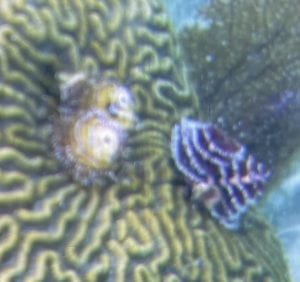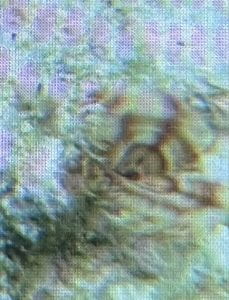After a good nights rest, we rose early in the morning to start off our day snorkeling at Glover’s Reef! We had all our gear and were ready to start our first snorkeling adventure by 8:05 am which was a record breaking time according to our professors. I was amazed by the biodiversity of marine life on our snorkel! I recorded hard corals, soft corals, damsel fish, puffer fish, parrot fish, lion fish, lobster, and many more interesting species! Nyala and Caio pointed out my first annelid- Christmas tree worms! These worms bore into coral and have a spiral-shaped crown that are always seen in pairs of two (even though it is actually one worm). They can come in all shapes and colors and will retract back into the coral as if they were never present if they sense water movement of a big fish or larger creature, like us. (sorry for the poor camera quality!)
Hydrozoa are hard to locate on the reef but I spotted some fire coral today! Fire coral is an interesting creature because it is an athecate hydroid that behaves like a reef-building coral.
We also built quadrates which is a tool used by field biologists to help us measure and collect data!
Later for our second snorkel of the day we were given two choices- the safe choice of the adventurous choice. The safe choice was to snorkel in the reef we had just been at while the adventurous choice required us to walk through the MOD… Mangroves of Death that had swarms of mosquitos that would bite you even as you were running. We of course chose the adventurous path, and the misquotes were terrible but the marine organisms we saw at this next location made it worth it. We saw many fish as well as a nerf shark and sting ray. I also got the chance to observe two more annelid species. The magnificent feather duster worm was a multicolored worm (red and white) with large feather-like bristles shaped like- you guessed it- a feather duster. This worm will also retreat into the coral if there is water movement. I think I also spotted a spaghetti worm’s long white, thin tentacles under the coral, but it was difficult to tell.
Afterwards we listened to some presentations that helped us learn more about different reef creatures and reflect on the journey ahead. More to come! 😉
~Maegan



